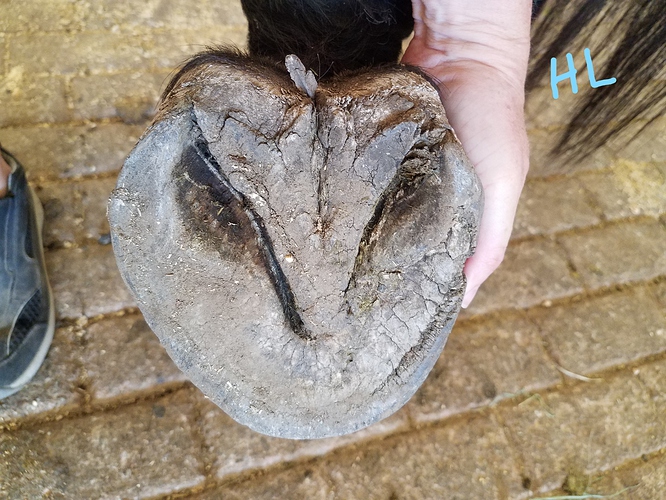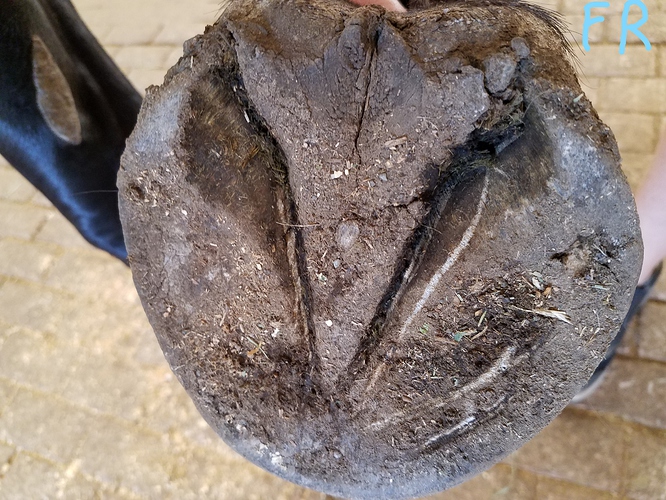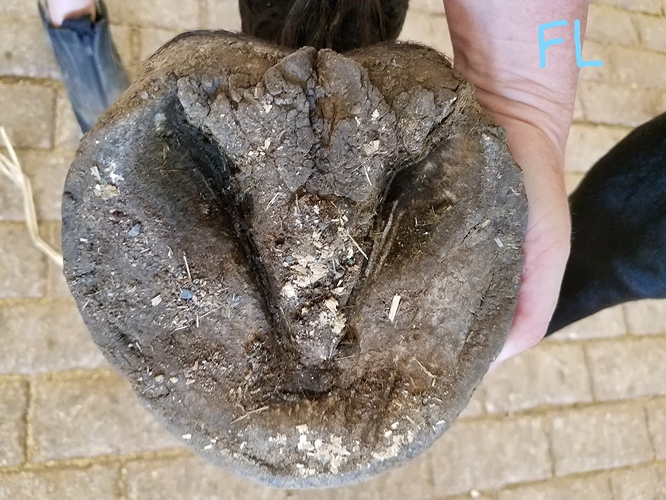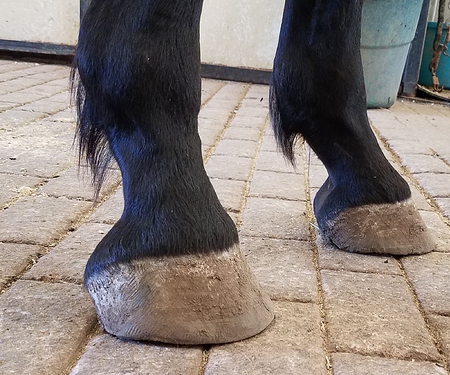These feet are well, interesting. I definitely have thoughts and opinions on them but I wanted to just hear some first reactions. And, although it is not a competition horse, would you think these would be okay to do some light jumping on, 3 ft and under? Sorry, I don’t have the hind right hoof photo for some reason. Just FR, FL, HL and fronts from the side. The one thing I will note is that although they’re all asymmetrical, they’re symmetrically asymmetrical!
!(upload://riAmCZA6UTlk8cHwZez36FUSVfE.jpeg)Is the horse sound? Does he trip?
The main thing I see here is a horse who hasnt been trimmed in 4 months, has likely been on a pasture, and has some flares and a bunch of retained sole thabt wants to shed off. Plus while the frog is nice and big, the heel bulbs are actually displacing the heels, hence the very high heels.
I would get this horse on a competent trim king schedule I think the underlying feet are decent enough he’s just been neglected. I would get the feet in shape before starting a serious riding program with him.
Good job! You’re guesses as to his hoof care and living are correct from what I know. I don’t know that date of his last trim however. There is another concern I think I might see, but I don’t want to bias anyone who might decide to respond so I won’t mention it yet.
Is horse paddling? That uneven wear is interesting.
The hooves are indeed uneven but they also show very little natural wear. Most horses have some asymmetry, its jusy kept in check by balanced trims.
I would not jump this horse as he is now. My guess is those feet point to a horse that is out of shape and hasn’t been ridden much.
I would get a good trimmer on board, open up the heels, and get a walk trot fitness plan going. I see nothing intrinsically wrong in the feet. They are overgrown but not disastrously so, and the basic hoof structure underneath looks OK. They will clean up good. If you have the option you might want to be conservative in your first trim, and trim every couple of weeks until his hoofs are balanced. Otherwise he could go tender on gravel or even have some hot hoof days adjusting to new angles.
I dont see any issues other than overgrowth. I’m quite familiar with the cycle of growth and wear in barefoot horses including what horses that have been out on a field for too long look like. It can all be remedied. But I would have it fixed before I started work.
I agree. They are decent feet that haven’t been cared for, but provided you use someone who knows how to trim they should end up as nice feet in only a couple of trims.
There’s a bunch of stuff going on which is all just due to overgrowth. There’s some stretching of the white line in the LH, there’s some thrush, there are likely some major ML imbalances due to the honking sized bars and mountains of dead sole etc. but as Scribbler said - underneath all of that are decent feet.
Thanks guys! I thought both front looked a little clubby but, the over growth makes sense. And this morning the horse was standing a bit more square so the pastern angles weren’t quite as upright as I was seeing in the photo. Yes, this horse as been out in pasture, not handled much at all. It was very lightly ridden 2x in the past 2 wks. The jumping question was more of a hypothetical, in the distant future sort of thing.
Yep. I’d be concerned about the long pasterns. I had one with long pasterns and he was in aluminum eggbars by 10 to keep him supported and keep them from sinking… and even then, he was retired in his mid-teens. Same kind of build… long pasterns with tiny pony feet.
Is this your horse ? Or are you buying it ?
Not my horse, but am working with it a little bit. The horse has much bigger issues than feet, but I was just curious what thoughts were on this one issue.
A couple of weeks ago I called highlow/club foot on a similar photo, but subsequent discussion pointed out how our cell phones really distort when one thing is closer than the other.
If you want us to evaluate pasterns, take a hoof plus ankle shot on each side.
There are several possibilities with pasterns.
There is length of pastern, there is angle of pastern, and there is symmetry between the two.
So the pastern can be long, normal, or short. And then the pastern can be dropped, normal, or upright.
The horse is most functional when the pastern angle matches the hoof angle.
If the two feet are at different angles, one foot is usually normal but the other foot is at a lower or a upright angle.
If the abnormal foot is steeper/more upright, we call that a club foot. If the not normal foot is lower/run forward, we call that a high-low problem.
If you want to post photos from both sides of the feet I might venture a comment on the pasterns. I have been fixing up a green pasture horse who had one scary run forward front hoof 18 months ago and is now totally normal, not 100 % symmetrical but so close you’d never notice.
However with so much overgrown foot all his angles will be off. I would start some considerate trimming before making a decision. I am curious about his other issues.
Pasture horses can get some combination of overweight plus poor topline that can make them look ewe necked or hunter bump. But also a certain percentage of horses on pasture are there because they did have some injury or personality disorder that made them unrideable.
I would say in general that while upright pasterns may make a horse a little less durable, they aren’t the big warning sign of dropped pasterns.
I’d be concerned that there might be some center sulcus thrush lurking in there. Just saying this as those feet (near heel) look like bigger versions of my mini’s when he had thrush hiding.




